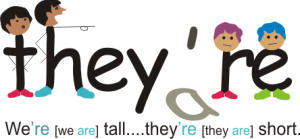There, They’re, and Their
There, They’re, and Their
There are some words that are just hard to remember how to spell, and if they sound the same as each other, it simply compounds the problem. I’m all for using images to help myself remember stuff, so let’s be kind and do the same for our kids! Here are a few of the tricks I used with my students when teaching these three words.
The Contraction “They’re”
Here’s a visual that you could show your students. Point out that the two guys on the left are drawing attention to the two short people on the right. The sentence under the stylized word shows the relationship between “we’re” and “they’re,” both derived from a word combined with what used to be “are.” I shared the story in another blog about how contractions came to be. Maybe a quick brush-up of that story will suffice to drive this concept deep into memory! Notice that in the sentence, the “’re” and the “are” are both light blue to tie the two together.
The Location Word “There”
Location words “here,” “where,” and “there” all have the word HERE in them. You can do a goofy sort of “who’s on first” using these words. Mom says “Come here and get your sandwich!” Child says, “Where?” Mom replies “There!” Note that in the picture, each here in the location words is light blue to tie them together in memory.
In order to help young children remember the -ere spelling, I would say that the location words all end with a sandwich. The e’s are the slices of bread and the r is the baloney in between the bread. You could teach this by drawing a simple crust around the e’s like this:
The Possessive Word “Their”
For some reason my students always had a really tough time remembering how to spell “their” and remembering when to use that word versus “there” or “they’re.” When teaching “their,” I used a little sentence and the following mini story and drew the action on a white board. Worked like acharm! Here’s how the story goes…There were two kids, who one day discovered that there were little evergreens growing up all over their backyard. When they asked their father about it, he explained to them that the pinecones that fell from the trees made new little trees. The thing is, they’d not noticed before because the mower always got to the little trees before they’d had a chance to grow big. This time, however, the mower was broken and the grass hadn’t been mowed for a while. So of course the kids didn’t want Dad to mow down the cute little trees! But after a bit of discussion, a compromise was reached: kids would choose the nicest tree they could find and plant it in a safe spot in the yard. Then Dad would mow the lawn. And that is what they did. The kids watched over their fir tree carefully and after a while it grew to be much taller than they were! How proud they were! When other kids came over to play, they made sure everyone knew the fir was theirs. I pointed out to my students that “their” and “fir” both end the same way. As a matter of fact, if you take the words “the” and “fir” and put them side by side, then erase the ‘f’ at the beginning of “fir” you will have the word “their”! Try it! I promise it will work!
http://child-1st.typepad.com/my_weblog/2010/04/tips-for-teaching-there-theyre-and-their.html




